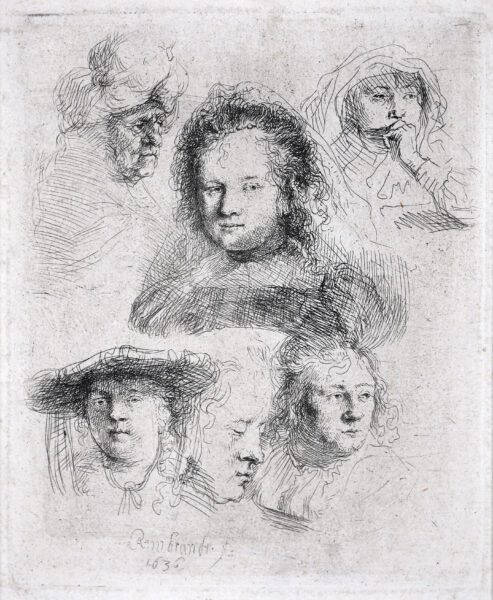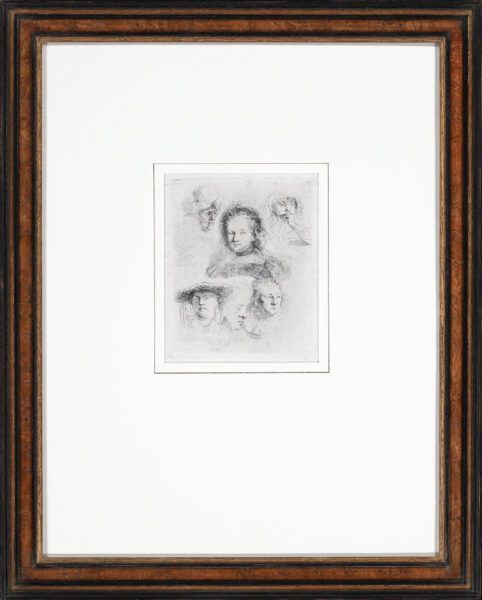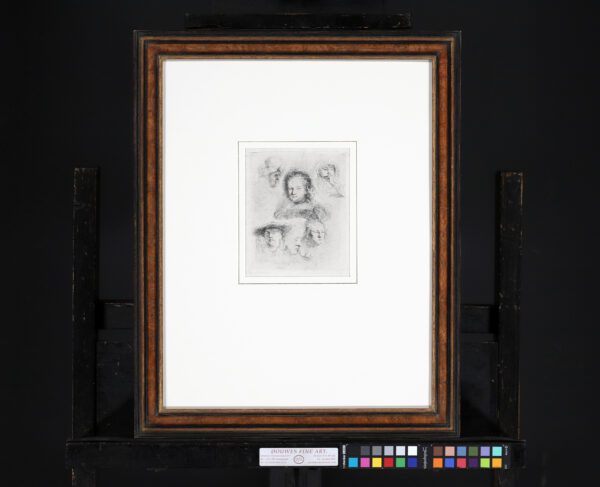“Studies of the Head of Saskia and others”, 1636
Etching: 16,8 x 13,6 cm
signed and dated lower left: ‘Rembrandt f. | 1636’
"*" indicates required fields
Notes
During his lifetime, Rembrandt’s extraordinary skills as a printmaker were the main source of his international fame. Unlike his oil paintings, prints travelled light and were relatively cheap. For this reason, they soon became very popular with collectors not only within but also beyond the borders of the Netherlands.
In 1634 Rembrandt married Saskia Uylenburgh, the daughter of a mayor of Leeuwarden. Rembrandt and Saskia had been married for two years in 1636, when Rembrandt etched this plate. Saskia is portrayed in the middle and at the bottom right and probably also in profile. The upper left portrait is an elderly woman and the other two younger faces are unknown women.
The young Saskia, at the age of twenty-five, is beautifully portrayed by her husband. The fact that Saskia’s health was weak throughout her life, did not keep Rembrandt from lending youthful determination to her facial expressions. She died in 1642 at the age of thirty, never having recovered her health after the birth of Titus, her only child to survive beyond the age of two months.
For these informal etched studies, he treated the copper printing plate as though it were a sheet of paper, perhaps even a page in a sketchbook. The image grows from – and criticises – the tradition of master artists designing prints as model sheets from which aspiring artists could learn to draw. Most such prints showed idealised figures executed in formulaic patterns of line. Rembrandt’s approach was based on direct observation and intuitive drawing. His composition appears casual, but in fact he took great care to vary the poses and lighting in each of the studies and to arrange them artistically on the plate.; Saskia is the largest and most detailed study. She seems unaware that Rembrandt was taking her likeness. Perhaps she had grown so accustomed to being observed that she took no notice. He took advantage of these unguarded moments to create remarkable personal images. She wears a high-necked dress, conveyed through the use of delicate cross-hatched lines and her wispy curls gently fall to her side. The two figures above her wear headdresses; the old woman in the upper left wears a turban and appears weary with age while the woman on the right covers her mouth with her left hand in a gesture of modesty or surprise. The three figures beneath Saskia seamlessly merge together, with the two figures to the right appearing older than the figure on the left. Each subject gazes off in a different direction, encouraging the viewer’s eyes to jump across the sheet, as if trying to discern what each subject is gazing at.
Literature
Bartsch 53; The New Hollstein Dutch 157: First state of 2.
Plate in existence at The Rembrandthuis Museum, Amsterdam
with Nowell-Usticke (1967): C1
A very fine lifetime impression, a light plate tone in places. With margins up to 9 mm around the platemark.
Provenance
- Private collection, Germany
- Private collection, The Netherlands





